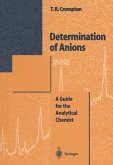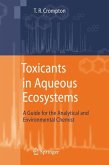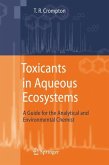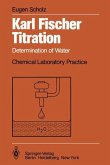- Broschiertes Buch
- Merkliste
- Auf die Merkliste
- Bewerten Bewerten
- Teilen
- Produkt teilen
- Produkterinnerung
- Produkterinnerung
The author has drawn together almost all published methods since 1975 on the determination of anions in all types of matrices. He presents the methods in a logical manner so that the reader can quickly gain access to the method and types of instrumentation available.
Andere Kunden interessierten sich auch für
![Determination of Anions Determination of Anions]() Thomas R. CromptonDetermination of Anions229,99 €
Thomas R. CromptonDetermination of Anions229,99 €![Toxicants in Aqueous Ecosystems Toxicants in Aqueous Ecosystems]() T.R CromptonToxicants in Aqueous Ecosystems113,99 €
T.R CromptonToxicants in Aqueous Ecosystems113,99 €![Toxicants in Aqueous Ecosystems Toxicants in Aqueous Ecosystems]() T.R CromptonToxicants in Aqueous Ecosystems113,99 €
T.R CromptonToxicants in Aqueous Ecosystems113,99 €![Karl Fischer Titration Karl Fischer Titration]() Eugen ScholzKarl Fischer Titration92,99 €
Eugen ScholzKarl Fischer Titration92,99 €![Analysis of Seawater Analysis of Seawater]() T.R CromptonAnalysis of Seawater229,99 €
T.R CromptonAnalysis of Seawater229,99 €![Analysis of Seawater Analysis of Seawater]() T.R CromptonAnalysis of Seawater226,99 €
T.R CromptonAnalysis of Seawater226,99 €![Analysis of Solids in Natural Waters Analysis of Solids in Natural Waters]() Thomas R. CromptonAnalysis of Solids in Natural Waters77,99 €
Thomas R. CromptonAnalysis of Solids in Natural Waters77,99 €-
-
-
The author has drawn together almost all published methods since 1975 on the determination of anions in all types of matrices. He presents the methods in a logical manner so that the reader can quickly gain access to the method and types of instrumentation available.
Produktdetails
- Produktdetails
- Verlag: Springer, Berlin
- Seitenzahl: 604
- Erscheinungstermin: 24. November 2011
- Englisch
- Abmessung: 235mm x 155mm x 33mm
- Gewicht: 901g
- ISBN-13: 9783642648359
- ISBN-10: 3642648355
- Artikelnr.: 36114251
- Herstellerkennzeichnung
- Springer-Verlag GmbH
- Tiergartenstr. 17
- 69121 Heidelberg
- ProductSafety@springernature.com
- Verlag: Springer, Berlin
- Seitenzahl: 604
- Erscheinungstermin: 24. November 2011
- Englisch
- Abmessung: 235mm x 155mm x 33mm
- Gewicht: 901g
- ISBN-13: 9783642648359
- ISBN-10: 3642648355
- Artikelnr.: 36114251
- Herstellerkennzeichnung
- Springer-Verlag GmbH
- Tiergartenstr. 17
- 69121 Heidelberg
- ProductSafety@springernature.com
1 Introduction.- 1.1 Rationale: Water Samples.- 1.2 Rationale: Solid and Gaseous Samples.- 1.3 Brief Summary of Methodologies.- 1.4 References.- 2 Halogen-Containing Anions.- 2.1 Chloride.- 2.2 Bromide.- 2.3 Iodide.- 2.4 Fluoride.- 2.5 Mixed Halides.- 2.6 Chlorate, Chlorite, Perchlorate and Hypochlorite.- 2.7 Bromate.- 2.8 Iodate.- 2.9 References.- 3 Nitrogen-Containing Anions.- 3.1 Nitrate.- 3.2 Nitrite.- 3.3 Nitrate and Nitrite.- 3.4 Free Cyanide.- 3.5 Total Cyanide.- 3.6 Cyanate.- 3.7 References.- 4 Sulphur Containing Anions.- 4.1 Sulphate.- 4.2 Sulphite.- 4.3 Thiosulphate and Polythionates.- 4.4 Thiocyanate.- 4.5 Sulphide.- 4.6 Polysulphide.- 4.7 References.- 5 Phosphorus Containing Anions.- 5.1 Phosphate.- 5.2 Condensed Phosphates.- 5.3 References.- 6 Silicon-Containing Anions.- 6.1 Silicate.- 6.2 References.- 7 Boron-Containing Anions.- 7.1 Borate.- 7.2 References.- 8 Carbonate, Bicarbonate and Total Alkalinity.- 8.1 Total Alkalinity.- 8.2 Carbonate.- 8.3 Bicarbonate.- 8.4 References.- 9 Metal-Containing Anions.- 9.1 Arsenite.- 9.2 Arsenate.- 9.3 Arsenite/Arsenate.- 9.4 Selenite.- 9.5 Selenate.- 9.6 Selenate/Selenite.- 9.7 Tellurate.- 9.8 Chromate/Dichromate.- 9.9 Germanate.- 9.10 Molybdate.- 9.11 Tungstate.- 9.12 Uranate.- 9.13 Vanadate.- 9.14 Titanate.- 9.15 Ferrocyanide.- 9.16 Metal Cyanide Complexes.- 9.17 References.- 10 Organic Anions.- 10.1 Formate and Acetate.- 10.2 Citrate.- 10.3 Isocitrate.- 10.4 Oxalate.- 10.5 Malate.- 10.6 Lactate.- 10.7 Salicylate.- 10.8 Ascorbate.- 10.9 Dehydroascorbate.- 10.10 Pyruvate.- 10.11 Glutamate.- 10.12 Amino Acids.- 10.13 Nitroloacetate and Ethylene Diamine Tetraacetates.- 10.14 Carboxylates.- 10.15 Sulphonates and Chlorolignosulphonates.- 10.16 Acetoacetate.- 10.17 Mixed Organic Anions.- 10.18 References.- 11 Applicationsof Ion Chromatography.- 11.1 Natural Waters.- 11.2 Rainwater.- 11.3 Potable Water.- 11.4 Industrial Effluents and Waste Waters.- 11.5 Boiler Feed Water.- 11.6 Plant and Soil Extracts.- 11.7 Foodstuffs.- 11.8 Column Coupling Isotachophoresis of Natural Waters.- 11.9 References.- 12 On-Site Measurement of Anions.- 13 On-Line Measurement of Anions.- 14 Preconcentration of Anions.- 14.1 Iodide.- 14.2 Phosphate.- 14.3 Sulphide.- 14.4 Borate.- 14.5 Arsenite.- 14.6 Selenate/Selenite.- 14.7 Chromate.- 14.8 Molybdate.- 14.9 Rhenate.- 14.10 Complex Anions.- 14.11 References.
1 Introduction.- 1.1 Rationale: Water Samples.- 1.2 Rationale: Solid and Gaseous Samples.- 1.3 Brief Summary of Methodologies.- 1.4 References.- 2 Halogen-Containing Anions.- 2.1 Chloride.- 2.2 Bromide.- 2.3 Iodide.- 2.4 Fluoride.- 2.5 Mixed Halides.- 2.6 Chlorate, Chlorite, Perchlorate and Hypochlorite.- 2.7 Bromate.- 2.8 Iodate.- 2.9 References.- 3 Nitrogen-Containing Anions.- 3.1 Nitrate.- 3.2 Nitrite.- 3.3 Nitrate and Nitrite.- 3.4 Free Cyanide.- 3.5 Total Cyanide.- 3.6 Cyanate.- 3.7 References.- 4 Sulphur Containing Anions.- 4.1 Sulphate.- 4.2 Sulphite.- 4.3 Thiosulphate and Polythionates.- 4.4 Thiocyanate.- 4.5 Sulphide.- 4.6 Polysulphide.- 4.7 References.- 5 Phosphorus Containing Anions.- 5.1 Phosphate.- 5.2 Condensed Phosphates.- 5.3 References.- 6 Silicon-Containing Anions.- 6.1 Silicate.- 6.2 References.- 7 Boron-Containing Anions.- 7.1 Borate.- 7.2 References.- 8 Carbonate, Bicarbonate and Total Alkalinity.- 8.1 Total Alkalinity.- 8.2 Carbonate.- 8.3 Bicarbonate.- 8.4 References.- 9 Metal-Containing Anions.- 9.1 Arsenite.- 9.2 Arsenate.- 9.3 Arsenite/Arsenate.- 9.4 Selenite.- 9.5 Selenate.- 9.6 Selenate/Selenite.- 9.7 Tellurate.- 9.8 Chromate/Dichromate.- 9.9 Germanate.- 9.10 Molybdate.- 9.11 Tungstate.- 9.12 Uranate.- 9.13 Vanadate.- 9.14 Titanate.- 9.15 Ferrocyanide.- 9.16 Metal Cyanide Complexes.- 9.17 References.- 10 Organic Anions.- 10.1 Formate and Acetate.- 10.2 Citrate.- 10.3 Isocitrate.- 10.4 Oxalate.- 10.5 Malate.- 10.6 Lactate.- 10.7 Salicylate.- 10.8 Ascorbate.- 10.9 Dehydroascorbate.- 10.10 Pyruvate.- 10.11 Glutamate.- 10.12 Amino Acids.- 10.13 Nitroloacetate and Ethylene Diamine Tetraacetates.- 10.14 Carboxylates.- 10.15 Sulphonates and Chlorolignosulphonates.- 10.16 Acetoacetate.- 10.17 Mixed Organic Anions.- 10.18 References.- 11 Applicationsof Ion Chromatography.- 11.1 Natural Waters.- 11.2 Rainwater.- 11.3 Potable Water.- 11.4 Industrial Effluents and Waste Waters.- 11.5 Boiler Feed Water.- 11.6 Plant and Soil Extracts.- 11.7 Foodstuffs.- 11.8 Column Coupling Isotachophoresis of Natural Waters.- 11.9 References.- 12 On-Site Measurement of Anions.- 13 On-Line Measurement of Anions.- 14 Preconcentration of Anions.- 14.1 Iodide.- 14.2 Phosphate.- 14.3 Sulphide.- 14.4 Borate.- 14.5 Arsenite.- 14.6 Selenate/Selenite.- 14.7 Chromate.- 14.8 Molybdate.- 14.9 Rhenate.- 14.10 Complex Anions.- 14.11 References.








